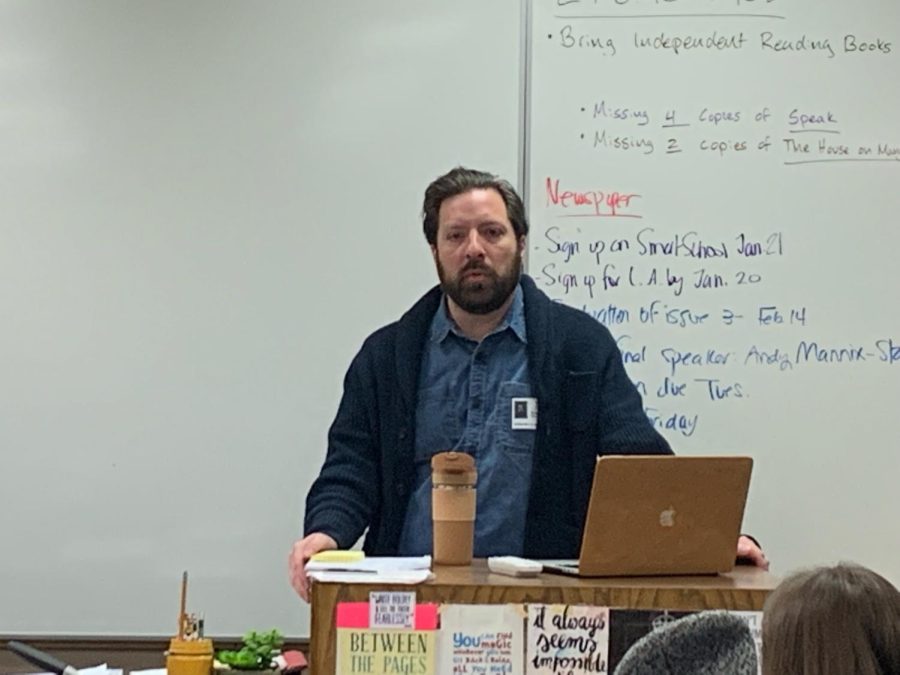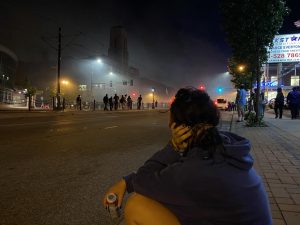Andy Mannix tells the other side to the George Floyd story
January 28, 2022
Click!
Tear gas diffuses into the air.
Bang!
Rubber bullets whistle past Andy Mannix, as terrified screams of the protesters rang out.
Although Mannix was a street’s distance away from the protest in front of vandalized police station, he fled as hoards of police officers flooded the area. The violence intensified in an instant. As the crowd of 10,000 people were freaking out, Mannix was preparing a story that was impacting lives all across the country.
For the past 6 years and 1 month, award-winning reporter Andy Mannix has been working for the Star Tribune. Founded in the 1930s when the Minneapolis Tribune and Minneapolis Daily Star merged, the Star Tribune developed into Minnesota’s largest local news source. Previously writing for the Minnesota Post, City Pages and the Seattle Times, Mannix has stayed longest with the Star Tribune. He graduated with a masters degree in investigative data journalism from UC Berkley, with past education at Stillwater Area High School and University of Minnesota. He often writes investigative stories and prides himself on telling the real, unbiased truth to every story he writes. Following George Floyd’s death, Mannix took as many opportunities as he was given to experience an up close look at the events of the not-so-peaceful protests.
“Our coverage of what happened last summer, the killing of George Floyd and the aftermath; I was out there from day one,” Mannix explained.
Waking up the morning of the protest, a feeling of dread creeps up into Mannix’s mind. Protests are not his favorite topic to cover. He describes them as the boring jobs they “send a person to keep an eye out and [that person] is usually right out of college,” however, he could tell there was more truth to unveil. Teaming up with Libor Jany, Mannix’s colleague and reporter, they collect their research. Since other news sources were publishing incorrect information about the death of George Floyd, Mannix and Jany set off hoping to discover the truth.
Mannix’s research informed him that other media sources had been covering the police version of George Floyd’s death. Finding that the police version was laced with false information, determination fueled him to tell the true story. This event had layers of unknown and Mannix was intent to dig deeper into the masked issues of police brutality. He could sense pressure from audiences waiting to figure out information, but he refused to spread false claims.
As Mannix and Jany arrive at the 3rd Precinct Police Station, they take in the pandemonium of the protest. The uncomfortable sound of shattering glass and the lingering fumes of spray paint was quite a shock. He worriedly realizes this protest is unlike anything he has ever experienced before, and “it was clear that this was going to be a different sort of protest.” Due to his badge and the cameras, surrounding protesters and police recognized Mannix as part of the media, placing a giant, red target on his back. Police officers littered the area, blasting protesters with rubber bullets and releasing tear gas among the crowds. The police were releasing a redundant amount of brutality towards the protesters, trapping Mannix in with the violence.
Bang!
Suddenly, he felt a sharp pain in his leg. The bullet left no blood, but the sting significant enough to turn his speedy walk into a hobble. The acts of vandalism from the misbehaving rioters led battalions of aggressive officers into groups of peaceful protestors. Despite his distance from the precinct, Mannix mentions he couldn’t escape the reckless and dangerous behaviors of officers, there to keep peace. He returns home, mostly unscathed, with a truthful story to write.
He wakes up the morning after the wild night prior and prepares to start writing. Glancing down at his leg, he sees a mark forming on his leg. The rubber bullet left a nasty patch of purple and green skin, stretching across his leg, so Mannix studies it intently. That mark serves as a reminder of the lack of consideration and mindfulness he witnessed. He found it extremely eye opening to experience, first hand, the violent actions of the police force. Despite the terrible events of the previous night, he starts on the article right away, passionate to clear up the media regarding the police.
“I live in Minneapolis, lived there for a long time. I’ve been to all these businesses. I’ve been to those Cub Foods and Targets that were on fire. It was surreal seeing this apocalyptic version of all of that,” Mannix states somberly.
Mannix, then, goes on to visit more action packed protest, as well as checking in with the Derek Chauvin trial. Spending long, tireless days and nights downing coffee after coffee, he began shaping a well developed story. He still “looks back to that time and remembers how intense it was.” After his writing wraps up, Mannix hopes he did enough to create an informative, truthful story and inspired other news sources to follow suit by telling the truth.
Click!
With a push of a button, the real story Mannix wrote of police brutality was public for all to see.










